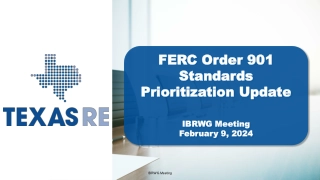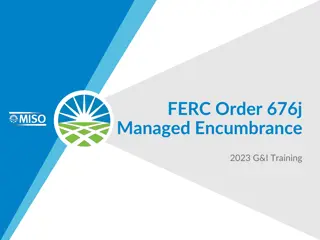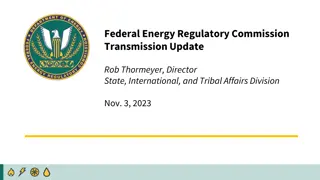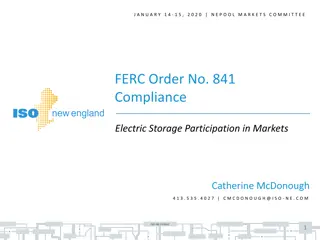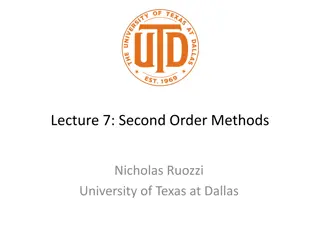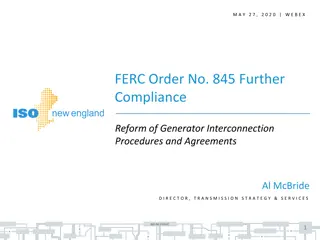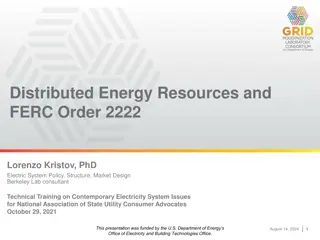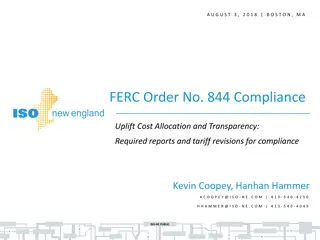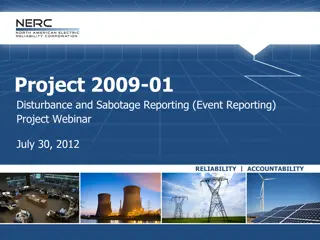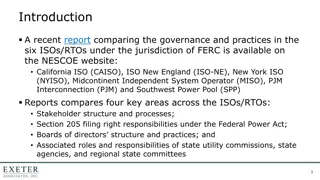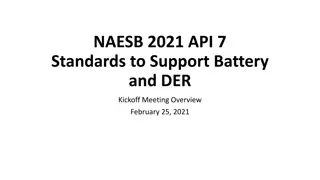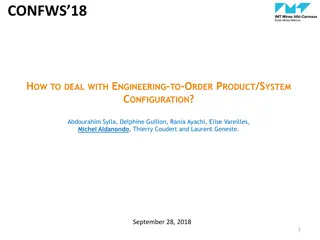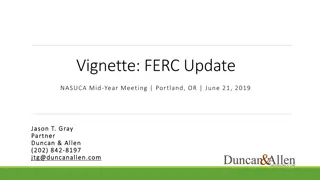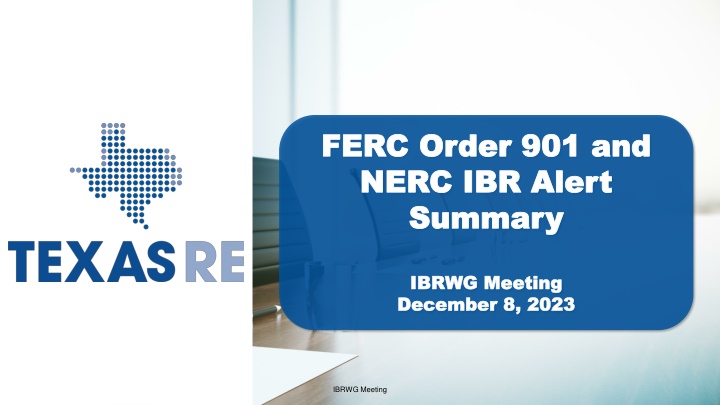
NERC IBR Key Findings and Takeaways from IBRWG Meetings
Discover key findings and takeaways from NERC IBR audits on bulk electric system facilities, including issues with voltage and frequency protection settings, underused reactive power capabilities, and recommendations for optimal equipment settings.
Download Presentation

Please find below an Image/Link to download the presentation.
The content on the website is provided AS IS for your information and personal use only. It may not be sold, licensed, or shared on other websites without obtaining consent from the author. If you encounter any issues during the download, it is possible that the publisher has removed the file from their server.
You are allowed to download the files provided on this website for personal or commercial use, subject to the condition that they are used lawfully. All files are the property of their respective owners.
The content on the website is provided AS IS for your information and personal use only. It may not be sold, licensed, or shared on other websites without obtaining consent from the author.
E N D
Presentation Transcript
Public FERC Order 901 and FERC Order 901 and NERC IBR Alert NERC IBR Alert Summary Summary IBRWG Meeting IBRWG Meeting December 8, 2023 December 8, 2023 1 IBRWG Meeting
Public NERC IBR Key Findings Many GOs did not have the requested facility data readily available About 5,200 MW of bulk electric system (BES) IBRs have voltage and frequency protection settings within the NERC PRC-024 no trip zone. About one-quarter of the reported facilities use phase lock loop (PLL) loss of synchronism protection with a trip threshold that results in an increased likelihood of inadvertent tripping during normally cleared grid faults. About one-quarter of the reported facilities use a fault ride-through mode that does not adequately support BPS reliability. About one-third of the reported facilities use a triangle-shaped facility reactive power capability curve, indicating a significant amount of underused reactive power capability 2 IBRWG Meeting
Public NERC IBR Key Findings Key Takeaways 2260 MW of BES solar facilities set inside of the no trip zone Voltage protection settings set directly on the PRC0-24 curve, indicating that these settings are not optimizing their ride- through capability Voltage protection settings set at inverter terminals and not compensated for voltage at POI 3 IBRWG Meeting
Public NERC IBR Key Findings Key Takeaways 1787 MW of BES solar facilities set inside of the no trip zone Frequency protection settings set directly on the PRC0-24 curve, indicating that these settings are not optimizing their ride-through capability 4 IBRWG Meeting
Public NERC IBR Key Findings Key Takeaways Use of instantaneous unfiltered measurements which are prone to inadvertent tripping Settings not based on maximum equipment capabilities Key Takeaways Combined active and reactive current injection is preferred (~ 73% of units) Momentary cessation, reactive injection only, and active injection only do not align with NERC disturbance findings 5 IBRWG Meeting
Public NERC IBR Key Findings Key Takeaways ~35% of resources have the triangle shaped capability curve, potential leaving significant reactive power capability unused Reactive capability artificially limited by plant controller settings Steady-state and dynamic reactive capability should be at least 0.95 power factor at maximum power output 6 IBRWG Meeting
Public FERC Order 901 Summary Issued October 19, 2023 Directs NERC to submit a detailed standards development plan to address inverter-based resource reliability gaps in four areas Data sharing Model validation Planning and operational studies Performance requirements Informational filing due within 90 days (by January 17, 2024) New or modified standards to be submitted by November 2026 7 IBRWG Meeting
Public FERC Order 901 Need for Reform Multiple events have demonstrated gaps in the Reliability Standards specific to IBRs Current actions are insufficient to address IBR reliability risks Existing Reliability Standards do not adequately address IBR reliability risks 8 IBRWG Meeting
Public IBR Reliability Gaps Data Sharing The Reliability Standards must require that generator owners, transmission owners, and distribution providers share validated modeling, planning, operations, and disturbance monitoring data for all IBRs with planning coordinators, transmission planners, reliability coordinators, transmission operators, and balancing authorities so that the latter group has the necessary data to predict the behavior of registered and unregistered IBRs individually and in the aggregate, as well as IBR-DERs in the aggregate, and their impact on the reliable operation of the Bulk- Power System. Registered IBRs data sharing Disturbance monitoring data Unregistered IBR and IBR-DER data sharing 9 IBRWG Meeting
Public IBR Reliability Gaps Model Validation The Reliability Standards must require that all IBR models are comprehensive, validated, and updated in a timely manner, so that planning coordinators, transmission planners, reliability coordinators, transmission operators, and balancing authorities can adequately predict the behavior of registered and unregistered IBRs individually and in the aggregate, as well as IBR-DERs in the aggregate, and their impacts on the reliable operation of the Bulk-Power System. Industry-approved generic component models Verification of IBR plant dynamic model performance Validating and updating system models Coordination to create and update planning, operational, and interconnection-wide data and models 10 IBRWG Meeting
Public IBR Reliability Gaps Planning and Operational Studies The Reliability Standards must require that planning and operational studies include validated IBR models to assess the reliability impacts of registered and unregistered IBRs individually and in the aggregate, as well as IBR-DERs in the aggregate, on the reliable operation of the Bulk- Power System, and must require that planning and operational studies assess the impacts of all IBRs within and across planning and operational boundaries for normal operations and contingency event conditions. 11 IBRWG Meeting
Public IBR Reliability Gaps Performance Requirements The Reliability Standards must ensure that registered IBRs Provide frequency and voltage support during frequency and voltage excursions in a manner necessary to contribute toward the overall system needs for essential reliability services Establish clear and reliable technical limits and capabilities for registered IBRs to ensure that all registered IBRs are operated in a predictable and reliable manner during normal operations and contingency event conditions Require that the operational aspects of registered IBRs contribute towards meeting the overall system needs for essential reliability services. Registered IBR frequency and voltage ride-through requirements Bulk power system planner and operator voltage ride-through mitigation activities Post-disturbance IBR ramp rate interactions and phase-lock-loop synchronization 12 IBRWG Meeting
Public NERC Standards Strategy for 2024 NERC must file standards by November 2024 2020-06 IBR definitions 2021-04 Modifications to PRC-002 (PRC-028) 2020-02 Modifications to PRC-024 2023-02 Performance of IBRs (modifications to PRC-004) New projects and SARS (2024 stretch target) Data sharing Data and model validation Planning and operational studies Data sharing for unregistered IBRs and DERs Data and model validation for unregistered IBRs and DERs 13 IBRWG Meeting
Public NERC Standards Strategy for 2025 NERC must file standards by November 2025 2023-05 FAC-001 and FAC-002 2023-01 EOP-004 2020-06 MOD-026 2023-08 MOD-031 2022-04 EMT models in MOD, TPL, and FAC Complete new projects to address Data sharing for registered IBRs, unregistered IBRs, and DERs Data and model validation for registered IBRs, unregistered IBRs, and DERs 14 IBRWG Meeting
Public NERC Standards Strategy for 2026 NERC must file standards by November 2026 2022-02 MOD-032 and TPL-001 Complete new projects to address Planning and operational studies for registered IBRs, unregistered IBRs, and DERs 15 IBRWG Meeting

